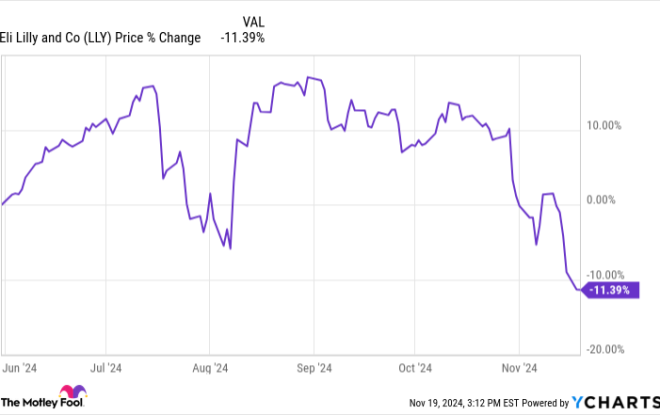Want a $1 Million Nest Egg by Retirement? Invest $250,000 in These 3 Stocks and Wait a Decade.
Who wouldn’t want to have a $1 million nest egg going into their retirement?
According to a recent CNBC survey, only 16% of respondents said they had that much when they retired — and that was counting all of their assets. But if you want to get there, the easiest way to do it is by setting aside money and investing it in the stock market. You could choose to buy index funds such as those that track the S&P 500 — that strategy is fairly safe over the long term, and ensures you’ll essentially earn returns that match the market.
Or you can build yourself a portfolio of individual stocks — that might get you better returns on your investments, but it’s a choice that comes with more risk of underperforming the market, and of losing money.
If you’re ready to take the risks of that second approach and are looking for tech stocks that could help you become a millionaire in retirement, here are three that I see as having the potential to quadruple in value over the next decade. Without any multiple expansion, doing that would require them to grow their profits by 15% a year — and that’s within their reach. Split a $250,000 investment between them, and growth like that would give you a $1 million portfolio in 2034.
1. ASML
ASML (NASDAQ: ASML) has one of the widest economic moats in the tech sector. It makes the lithography equipment used to manufacture semiconductors, and it’s the only company able to make the most advanced versions of that equipment — extreme ultraviolet (EUV) lithography systems. These, in turn, are the only machines that can make today’s most advanced, component-dense chips.
ASML has built up its technological lead thanks to a generation of research and development, and consistent investments in advancing its technology. At this point, it will be difficult for rivals to catch up. That competitive advantage should help drive ASML’s outperformance in the coming years as demand for its machines is set to grow thanks to AI-driven demand for the most advanced chips.
The company’s market cap is already $332 billion, meaning that if it gains 300% in the next decade, it would have a market cap of $1.33 trillion. And while there are only seven companies on the market today with trillion-dollar valuations, considering the production ramp-up taking place in the semiconductor industry, that goal is within reach for ASML.
In addition, ASML pays a dividend. It’s modest, yielding just 0.8% at the current share price, but reinvesting those payouts could help investors reach their goals a bit quicker.
2. Arm Holdings
Arm Holdings (NASDAQ: ARM) is another intriguing tech stock with the potential to help make you a millionaire over the next decade.
Like ASML, Arm has unique competitive advantages that make it a good candidate to ride the AI boom. Unlike most of its chip stock peers, Arm doesn’t design its own chips. Instead, it licenses its technology to companies like Apple and Nvidia, which use its architectures in their chips. Arm’s components are particularly valued in smartphones because they use much less power than competing options like the x86 from Intel and AMD.
That energy-conserving aspect is also making Arm’s products popular with data center operators, as running AI applications demands a tremendous amount of electricity, and savings at scale can be significant.
Finally, Arm generates wide operating margins thanks to its technology and unique business model, and as it rolls out new products and demand for AI soars, it seems likely to benefit. The company looks like a good bet to grow profits by at least 15% annually and retain its lofty earnings multiple.
3. The Trade Desk
The robust growth of digital advertising seems likely to continue as companies shift more of their marketing budgets from conventional advertising to digital channels, and brands seek out new ways to reach customers. One company that’s well positioned to take advantage of that opportunity is The Trade Desk (NASDAQ: TTD), the leading independent demand-side ad tech platform.
The Trade Desk has long outperformed both its ad tech peers and the broader market. And, it should keep capitalizing on the digital ad market’s growth thanks to its new AI platform, Kokai. This product makes it easier for customers to track and measure how their ad campaigns are performing, allowing them to adjust to campaigns in response to customer behavior, and helping advertisers make better decisions.
The Trade Desk has a track record of delivering growth even in periods when advertisers are tightening their belts, and the company should be able to capitalize on new platforms and media channels as they evolve over the next decade. Based on its history, it’s a good bet to quadruple its earnings per share over the next decade.
Don’t miss this second chance at a potentially lucrative opportunity
Ever feel like you missed the boat in buying the most successful stocks? Then you’ll want to hear this.
On rare occasions, our expert team of analysts issues a “Double Down” stock recommendation for companies that they think are about to pop. If you’re worried you’ve already missed your chance to invest, now is the best time to buy before it’s too late. And the numbers speak for themselves:
-
Amazon: if you invested $1,000 when we doubled down in 2010, you’d have $21,266!*
-
Apple: if you invested $1,000 when we doubled down in 2008, you’d have $43,047!*
-
Netflix: if you invested $1,000 when we doubled down in 2004, you’d have $389,794!*
Right now, we’re issuing “Double Down” alerts for three incredible companies, and there may not be another chance like this anytime soon.
*Stock Advisor returns as of October 7, 2024
Jeremy Bowman has positions in The Trade Desk. The Motley Fool has positions in and recommends ASML, Advanced Micro Devices, Apple, Nvidia, and The Trade Desk. The Motley Fool recommends Intel and recommends the following options: short November 2024 $24 calls on Intel. The Motley Fool has a disclosure policy.
Want a $1 Million Nest Egg by Retirement? Invest $250,000 in These 3 Stocks and Wait a Decade. was originally published by The Motley Fool





Leave a Reply